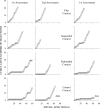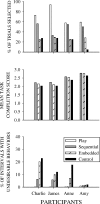Evaluating preschool children's preferences for motivational systems during instruction
- PMID: 17624066
- PMCID: PMC1885410
- DOI: 10.1901/jaba.2007.59-05
Evaluating preschool children's preferences for motivational systems during instruction
Abstract
Preschool teachers rely on several strategies for motivating children to participate in learning activities. In the current study, we evaluated the effectiveness of and preference for three teaching contexts in which embedded, sequential, or no programmed reinforcement was arranged. The embedded context included highly preferred teaching materials, the sequential context included highly preferred edible items for correct responding, and a control context included neither. In addition, an exclusively play-oriented activity was included as a fourth option to determine if one of the direct teaching contexts could compete with a relatively unstructured and exclusively child-led activity. All participants preferred the sequential context (use of high-quality consequences) over the embedded context (use of high-quality teaching materials), 2 of the 4 participants preferred some motivational system to none at all, and the play area was selected over all variants of the instructional contexts during the majority of trials. We found either no or small differences in correct responding in the different instructional contexts; however, rates of undesirable behavior were highest in the least preferred interaction area for 3 of the 4 participants. Implications for the design of effective and preferred teaching environments for young children are discussed.
Figures



Similar articles
-
An evaluation of the relative efficacy of and children's preferences for teaching strategies that differ in amount of teacher directedness.J Appl Behav Anal. 2009 Spring;42(1):123-43. doi: 10.1901/jaba.2009.42-123. J Appl Behav Anal. 2009. PMID: 19721734 Free PMC article.
-
Assessing the value of choice in a token system.J Appl Behav Anal. 2010 Fall;43(3):553-7. doi: 10.1901/jaba.2010.43-553. J Appl Behav Anal. 2010. PMID: 21358919 Free PMC article.
-
Effects of reinforcement choice on task responding in individuals with developmental disabilities.J Appl Behav Anal. 1997 Fall;30(3):411-22. doi: 10.1901/jaba.1997.30-411. J Appl Behav Anal. 1997. PMID: 9316256 Free PMC article.
-
The effects of reinforcer pairing and fading on preschoolers' snack selections.J Appl Behav Anal. 2007 Winter;40(4):633-44. doi: 10.1901/jaba.2007.633-644. J Appl Behav Anal. 2007. PMID: 18189095 Free PMC article.
-
Determining preschoolers' preferences for choice-making opportunities: choice of task versus choice of consequence.J Appl Behav Anal. 2010 Fall;43(3):503-7. doi: 10.1901/jaba.2010.43-503. J Appl Behav Anal. 2010. PMID: 21358910 Free PMC article.
Cited by
-
A further analysis of the value of choice: controlling for illusory discriminative stimuli and evaluating the effects of less preferred items.J Appl Behav Anal. 2009 Fall;42(3):711-6. doi: 10.1901/jaba.2009.42-711. J Appl Behav Anal. 2009. PMID: 20190933 Free PMC article.
-
Toward effective and preferred programming: a case for the objective measurement of social validity with recipients of behavior-change programs.Behav Anal Pract. 2010 Spring;3(1):13-21. doi: 10.1007/BF03391754. Behav Anal Pract. 2010. PMID: 22479668 Free PMC article.
-
An assessment of the efficiency of and child preference for forward and backward chaining.J Appl Behav Anal. 2011 Winter;44(4):793-805. doi: 10.1901/jaba.2011.44-793. J Appl Behav Anal. 2011. PMID: 22219530 Free PMC article.
-
A Treatment Evaluation of Successive and Simultaneous Visual Stimulus Presentation During Tact Training with Children with Autism.Anal Verbal Behav. 2023 Sep 21;39(2):206-225. doi: 10.1007/s40616-023-00192-1. eCollection 2023 Dec. Anal Verbal Behav. 2023. PMID: 38075503 Free PMC article.
-
Distributed and accumulated reinforcement arrangements: evaluations of efficacy and preference.J Appl Behav Anal. 2014 Summer;47(2):293-313. doi: 10.1002/jaba.116. Epub 2014 Apr 30. J Appl Behav Anal. 2014. PMID: 24782203 Free PMC article.
References
-
- Bredekamp S, Copple C. Developmentally appropriate practice in early childhood programs (rev. ed.) Washington, DC: National Association for the Education of Young Children; 1997.
-
- Bricker D, Pretti-Frontczak K, McComas N.R. An activity-based approach to early intervention (2nd ed.) Baltimore: Brookes; 1998.
-
- Bruner J.S. The act of discovery. Harvard Educational Review. 1961;31:21–32.
-
- Daly E.J, Martens B.K, Hamler K.R, Dool E.J, Eckert T.L. A brief experimental analysis for identifying instructional components needed to improve oral reading fluency. Journal of Applied Behavior Analysis. 1999;32:83–94.
Publication types
MeSH terms
LinkOut - more resources
Full Text Sources

